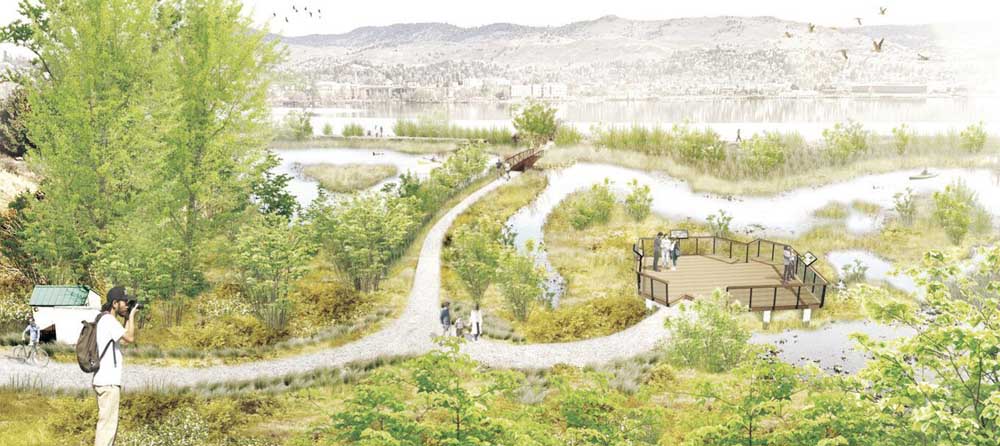Klamath Basin restoration projects net $46 million in funding
Published 12:30 pm Saturday, November 2, 2024

- A rendering of the Lake Ewauna wetlands following project completion.
Restoration projects across the Klamath Basin will be awarded $46 million through the collaborative efforts of the Klamath Basin Restoration Keystone Initiative.
Funding, provided by the Biden administration’s Investing in America Agenda, will support 24 restoration projects, a news release from the Department of the Interior said.
All projects were developed by the parties which signed a Motion of Understanding in February to ensure collaborative progress.
The MOU brought everyone to the table for the Keystone Initiative, including the Klamath, Yurok and Karuk Tribes, agricultural partners, conservation groups and federal agencies.
“It’s inspiring to help advance our efforts to achieve a drought-resilient and restored ecosystem in this region,” U.S. Fish and Wildlife Service Director Martha Williams said in the news release. “I am grateful for the work with Tribes and many partners to collectively choose projects focused on holistic solutions in the basin that will continue for many generations to come.”
The groups met regularly to discuss and prioritize projects with input from all perspectives, with this most recent allocation of federal funding from the Department of the Interior and U.S. Fish and Wildlife Service promised to the chosen projects.
The largest sum — $13 million in total — was awarded to restoring the Agency-Barnes wetlands in the Upper Klamath National Wildlife Refuge and to plans to provide fish habitat access in Fourmile and Sevenmile Creeks.
“Covering 14,356 acres, the restored wetland will create vital habitat for waterfowl, federally endangered Lost River and shortnose suckers and other species,” the news release reads, making the Agnes-Barnes project one of the largest wetland restoration initiatives in the history of the United States.
The wetlands project is the result of collaboration between the Klamath Tribes, Ducks Unlimited and USFWS on behalf of endangered fish species as well as waterfowl affected by the loss in habitat in recent years.
Chairman William Ray Jr. of the Klamath Tribes said this funding represents a “critical step” in efforts to improve water quality, wetlands and the watershed as a whole.
“I saw hope, and I saw optimism to save our C’waam and Koptu mullet fish,” Ray Jr. said. “I see that the project at Agency-Barnes will help our water quality, and that gives us a lot of hope for our cultural renewal and continued success.”
This round of funding will complete the second and third phases of the wetlands project.
A news release from the Klamath Tribes and Ducks Unlimited also noted a sizable award of $2.7 million to install four new irrigation pumps to ensure water remains on the Lower Klamath and Tule Lake National Wildlife Refuges, which serve as critical habitat for migratory waterfowl.
“Together, these pumping stations will improve water supply reliability and functionality on over 20,000 acres of wetland habitat on both (refuges),” the release reads.
Another set of projects to restore Lake Ewauna in Klamath Falls will total $3 million and be aimed at benefiting fish, wildlife and people.
Endangered salmon, C’waam and Koptu fish will be given improved habitats in the lake and connecting Link River, also benefiting the migrating waterfowl species in the area.
As for local agricultural producers, the long-awaited “flow-through” infrastructure will be receiving a sum of $2.54 million, aiding farmers and ranchers by increasing water availability.
The flow-through project serves to keep water on the lands while also cleaning the flows prior to their return into the river systems.
“This project encompasses a suite of infrastructure improvements and operational changes to provide natural ecosystem services with respect to water quality in the Klamath Basin,” the Interior’s release reads. “Water used for farmland irrigation would then flow through wetlands before returning to the Klamath River.”
The project also serves to recharge groundwater losses from recent years of drought.
A full list of restoration projects can be viewed on the U.S. Fish and Wildlife Service website at fws.gov/program/klamath-basin-project-awards/what-we-do.
The Herald and News is a news-sharing partner with the Rogue Valley Times.






